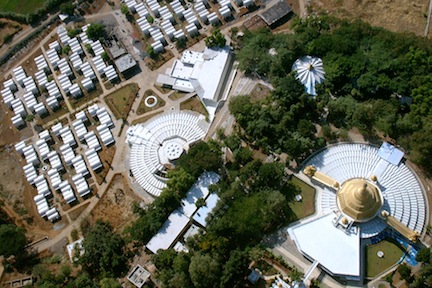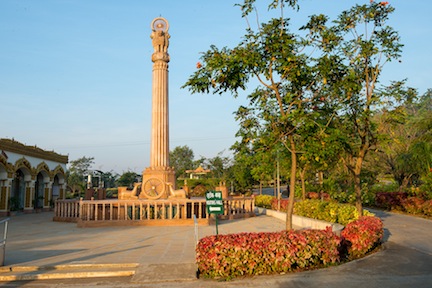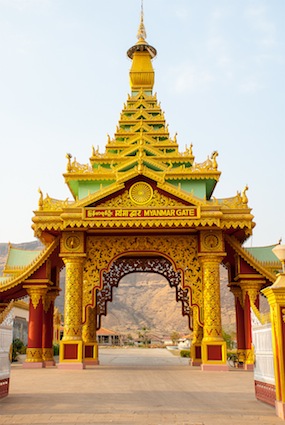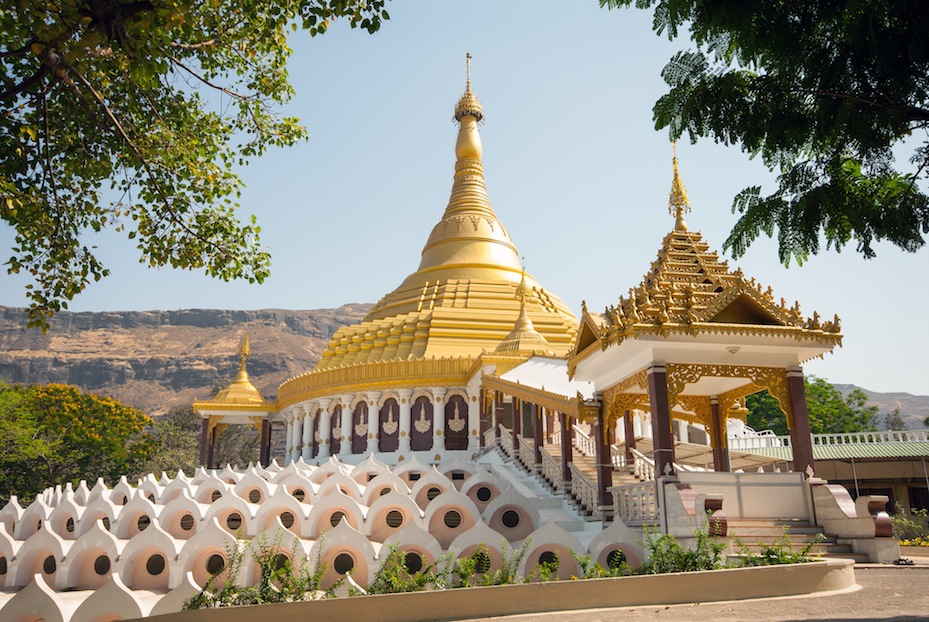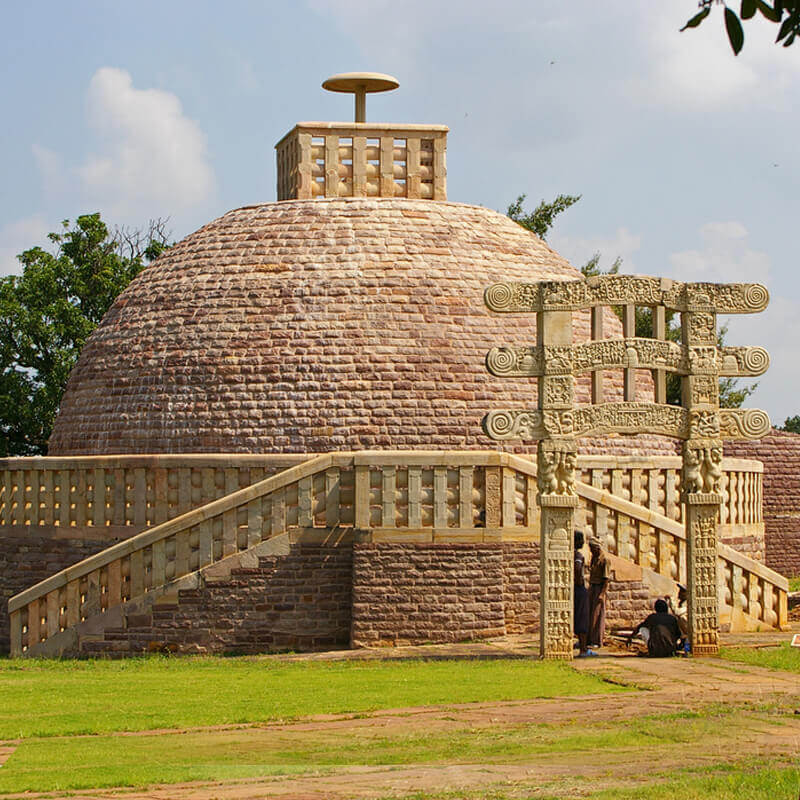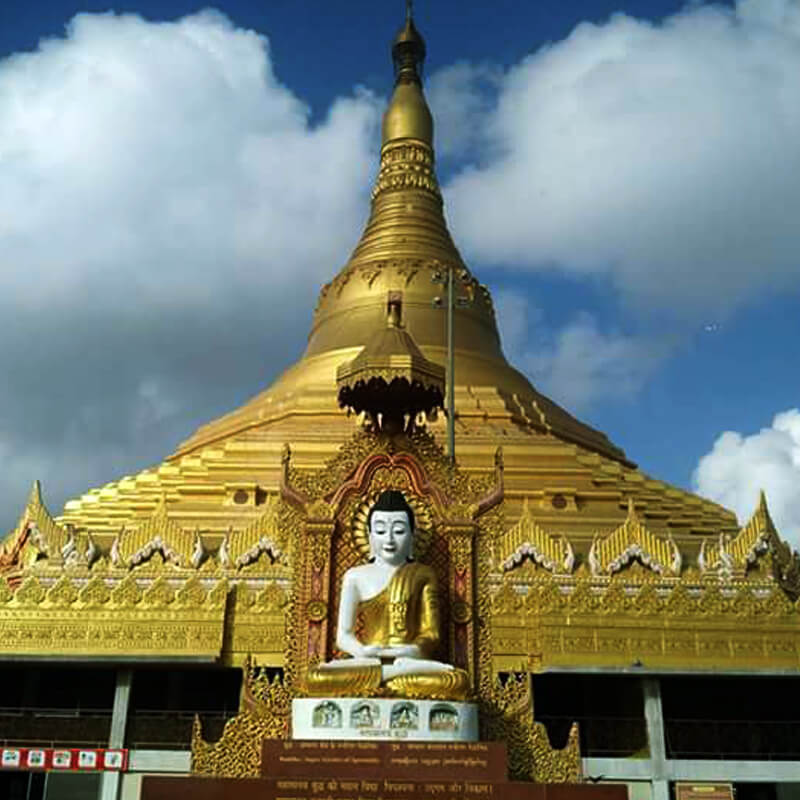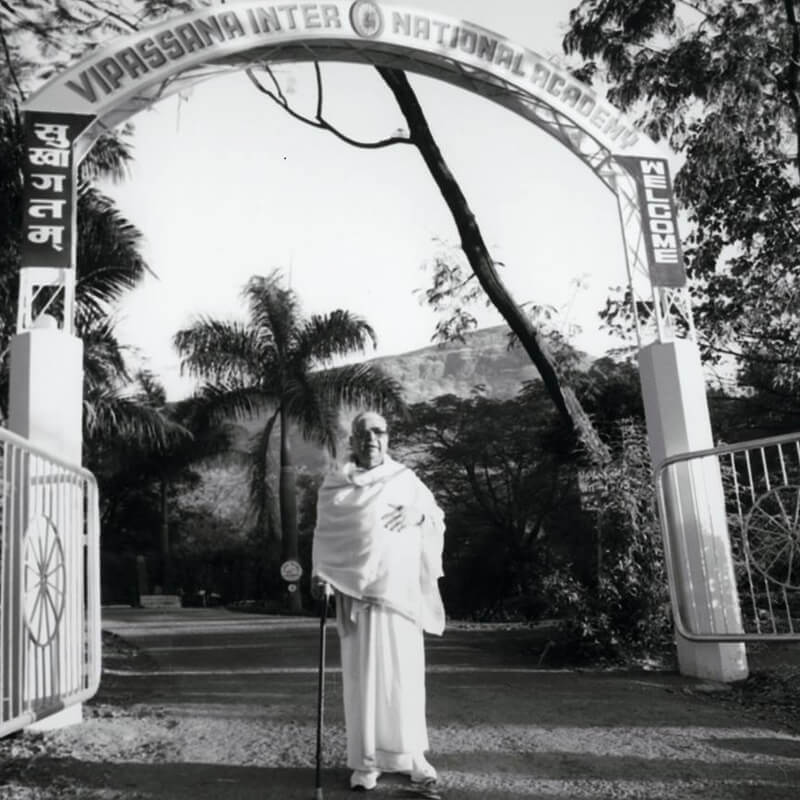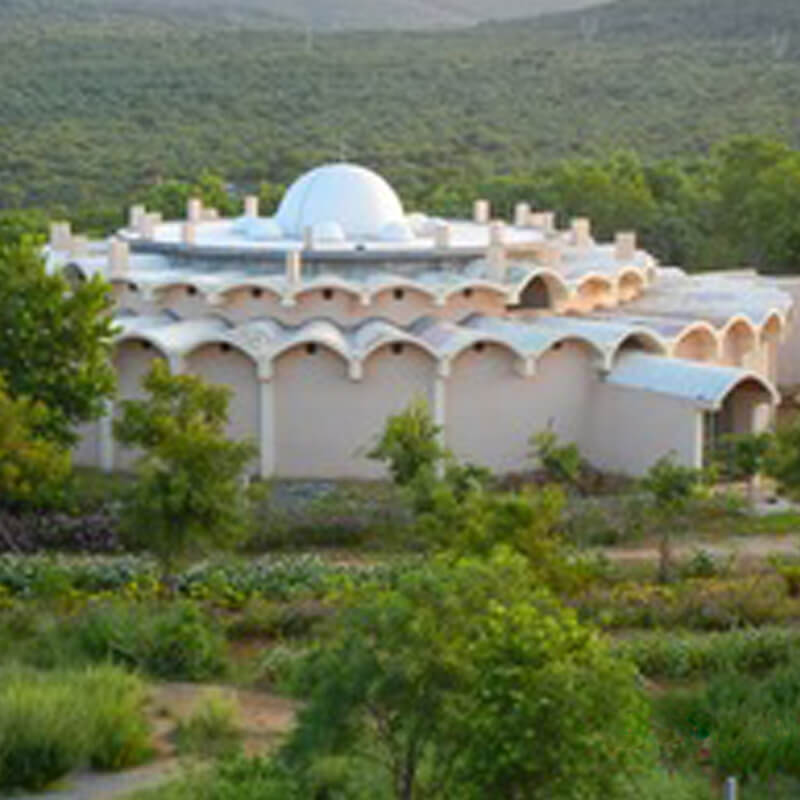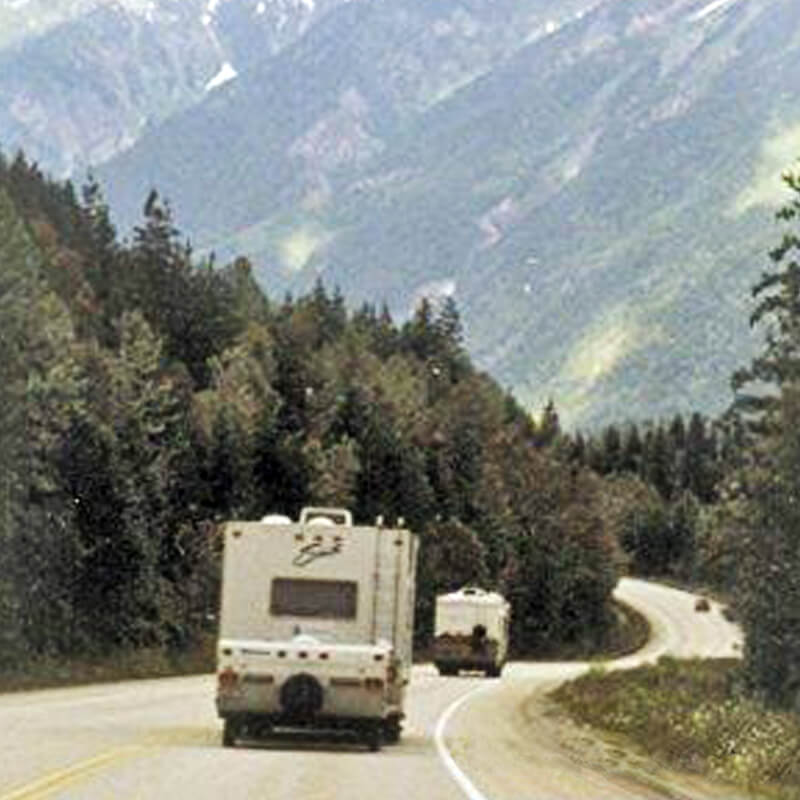
(Dhammagiri, the plateau of peace (1983))
A few hundred yards from the sleepy railway station, a small group of seven men, all Vipassana meditators, slowly made their way up a deserted hill. One of them had his foot in plaster. He hobbled along painfully with a crutch. The others addressed him as ‘Guruji’. S.N. Goenka and the group reached the top of the hill, a desolate land with ancient ruins and a few scattered trees. Nearby, the group could see bodies burning in a cemetery. “Guruji, this place could hardly be ideal for a meditation centre”, one amongst the group said nervously. Goenkaji smiled. “On the contrary, this is the ideal place. You can see the ultimate fate of this physical body for which we have so much attachment”. The Dhamma teacher experienced the vibrations on the lonely hill. “We were not looking for this place”, he said quietly. “This place was looking for us”. After millennia, the priceless jewel of Dhamma had found a casket--Dhamma Giri.
The Early Days
From 1969 to December 1975, Vipassana courses had already been held in 11 Indian states and 37 towns and cities. Courses were organized in wadis, schools, colleges, hostels, hotels, dharamsalas, ashrams, temples, viharas, bungalows, offices, a stadium, a jail, a mosque. The Ganges of Dhamma had begun to flow in the country of its origin.
Soon, the decision was taken to have a Vipassana centre. The search for a suitable land began.
There were, however, formidable obstacles, not all of them financial. One was that while the Buddha is held in high respect in India, Buddhism is widely regarded with suspicion. If a centre was founded to spread the teaching of the Buddha, it might be regarded as a sectarian institution, in which case its appeal would be limited only to the small minority of Buddhists in India. Aware of this danger, Goenkaji emphasized strongly the non-sectarian, universal nature of Vipassana meditation. He made it clear that Dhamma Giri was not to be the property of any group, but was for the benefit of all who sought a way out of suffering.
Another problem was that Indians were unfamiliar with the system of pure dāna(donation). At the non-centre camps, students paid for their own room and board. There was nothing wrong in such a system, but Goenkaji felt that a Dhamma centre should not operate on this basis. He recalled his Teacher's own policy. Sayagyi had written, "There is no admission or subscription fee or fixed donation payable by my disciples…. We accept aid only from disciples who have purified themselves with Vipassana meditation. If one can help the people to enjoy the fruits of meditation and if they know that the results obtained are for their well-being, tangible, here-and-now, and concrete, you cannot prevent them from doing their might to give better facilities for the promotion of the Dhamma."
The starting of a centre was thus not just a matter of finding the right piece of land and the money to pay for it. There must be the proper foundation: the wish to experience and share with all others the benefits of Vipassana meditation.
However, Goenkaji was confident that the Dhamma would overcome these obstacles. He worked tirelessly to realize his Teacher's goal of establishing a centre from which the Dhamma could spread not only in India but around the world.
As this great project has developed many Vipassana meditators have become involved in it and in time thousands of them have come to Dhammagiri to meditate and give their help in establishing the center. Their own words and those of Goenkaji help to tell the story of the early years of Dhammagiri.
Purchase of the First Piece of Land
In December 1973, I attended my first Vipassana course at Deolali, near my home in Igatpuri. I found the course hard but rewarding. On the last day, I learned by chance that Goenkaji had been looking for a site for a meditation center near Bombay. The thought came to me that Igatpuri was the most suitable location for such a center. I was eager for the inexhaustible spring of Dhamma to well forth from the town where I lived. I went to Goenkaji and invited him to stop for tea at my house on his way back to Bombay after the course. I assured him that he would not be delayed more than five minutes, since my home stood by the side of the road that he must travel from Deolali to Bombay. My plan was, once he was in my home, to broach the subject of a site for a center.
At first, Goenkaji's reply was not encouraging. "If I stop at every house where I am invited along the way, how will I ever reach my home?" he asked. But in response to my urgent requests, he kindly accepted my invitation, only warning me, "See that the five minutes do not turn into five hours!"
I was filled with joy that my plan had worked so far, but also apprehensive that it might yet fail. In my anxiety, I wanted to set out at once for my home, lest Goenkaji should pass me on the way. He would be travelling by car, while I would have to take the bus or train, which was naturally much slower. It was now lunchtime. I went to the dining room to say goodbye to Mr. Rangil Mehta, a fellow meditator who had given me a lift to the course. Hearing of my plan, he offered his assistance. "Let us have our lunch," he said. "Then we shall all go together in my car, and reach Igatpuri in no time."
All went as I had hoped. We were in plenty of time to welcome Goenkaji when his car arrived at Igatpuri. As we were drinking tea in my home, I requested that if he could spare the time now, I might show him a few possible sites for a meditation center near my town. He gave his consent, and with Mr. Mehta, we set off to look at the properties.
The first one or two sites that I showed Goenkaji obviously did not meet with his approval. I asked for clearer guidelines about the kind of place that he had in mind. He told me, "I would like a site that is not in the midst of the town but not too remote either, where connections could easily be arranged for water, electricity, and telephone, and where access would not be too difficult." I immediately thought of showing him the land where Dhamma Giri now stands.
At that time, there was no proper road into the property, but Mr. Mehta did not hesitate to risk his car on the rough, uneven track. We went as far as the car could take us, and then got out. Goenkaji looked closely all about him, and within just a few minutes, he decided that this was what he had been looking for. After millennia, the priceless jewel of Dhamma had found a casket in the land of its origin.
At that moment, someone pointed out a cremation taking place at the foot of the hill on which we stood. I was worried that the proximity of a cremation ground would make Goenkaji change his mind about the site. But he said with a smile, "Good! This will continually implant the awareness of anicca (impermanence) in the minds of meditators."
Then and there, Mr. Mehta offered to purchase the property and donate it to the Trust. Before we left, he had noted all the details in order to conclude the transaction speedily. After returning to Bombay, Mr. Mehta went directly to the owner of the deserted site, made the payment and only then went home. The land for the first Vipassana centre in India after millennia was ready.
All of this took five hours-a long time for a cup of tea! Goenkaji was well justified in his suspicion that stopping at my house would take much more than five minutes.
That day, December 16, 1973, was the happiest day of my life. Since then I have practiced Vipassana faithfully and given whatever free time I have to serve the Dhamma so that many may experience the happiness of liberation.
-(By Bhojraj Sancheti, Igatpuri)
Goenkaji named the new center “Dhammagiri”, meaning the Hill of Dhamma. Very soon it began to attract Vipassana meditators.

(View of the original buildings,taken from the area where the Pagoda now stands (1975))
The First Meditators at the New Center
I first came to Dhammagiri in early 1974. After a course near Bombay, I had asked Goenkaji for permission to visit the newly-purchased land. He told me to go ahead, and to contact Mr. Bhojraj in Igatpuri. I went there along with a friend, and Mr. Bhojraj took us up the hill. At that time the site consisted of three or four old bungalows and the surrounding land. There was a family of farmers still living in the little bungalow nearest the mountain. Mr. Bhojraj opened up the easternmost building for us, which is where the farmers used to keep their goats. The floor was covered with dung and the walls were black from years of cooking fires.
I stayed about a week and then left. When I came back a few weeks later, Graham Gambie had arrived. Together we set up housekeeping and started meditating on the site. We wrote to Goenkaji and asked him what work we should do to start improving the place—cleaning, planting gardens, or whatever. He wrote back, “Dear Graham and Geo: Be happy! Meditate, meditate, meditate. Clean yourselves and clean the meditation center. Don’t do anything else, just meditate.” And that is what we did.
First there was some basic cleaning that was necessary for us to use the place. We carried buckets of water up from the well, threw them on the floor, and scrubbed away on our hands and knees. And then we started meditating, perhaps six to eight hours a day. It was hard enough with the farmers in the next building, arguing and yelling and screaming. But after a while the farmers moved out.
Then Sonu, the deaf laborer, was hired to work at the site. He started whitewashing the walls of the bungalow where we were living, which went from black to dark gray to light gray to white after about eight coats of whitewash. We would meditate in one room and Sonu would whitewash in another. When he had finished the room where he was working, he would move to the next and start whitewashing there. One day I must have been getting a little bored with meditating, so I motioned to Sonu that I would help him whitewash. In gestures he told me emphatically, “You meditate, I’ll whitewash!”
During the monsoon season, we would put our foam cushions above the stone floor on little 2” high wooden platforms, because it was so damp the cushions would soak up the water. One time while I was meditating, I felt a really strong pain in my big toe. I thought it was just a strange sankhāra [reaction], so I just sat and observed. And then I felt another one, and another one. So I looked down and there was this little mouse—he’d take a bite of my toe and slip underneath the platform after each bite. And the ants! I used to wrap myself up in this elaborate way so that it would take at least 45 minutes for the ants to find my neck or my eyelids or my face.
From time to time Goenkaji would come to lay out the building plans and inspect progress. I remember when he decided where the Pagoda would be. At that time the Plateau of Peace [where the Pagoda stands] was just a field without any trees, but we had a group sitting there: Goenkaji, Graham, Narayan Dasarwar [now manager of Dhammagiri], and myself. I was there when the four Bodhi trees were planted on the Plateau of Peace. Graham had brought the trees from Sarnath, Bodhgaya, Sravasti, and Burma.
Building started in 1975. The Trust hired a contractor to construct facilities for about 80 people. At the same time Goenkaji gave the westerners living at Dhammagiri permission to build thatched mud huts for meditators, in traditional Indian village style. Once construction started, there was a whole encampment of laborers and their families and animals living on the site.
-By Assistant Teacher Geo Poland, Canada
* * * * * *
In the early days before there was any building going on, everyone who was there would meditate six to eight hours a day. There was more to do in terms of keeping yourself alive then; there was no water, electricity, or plumbing, just an empty building to stay in.
Dhammagiri wasn’t a retreat environment. It was like living in a hut out in the desert. We were living on an isolated hilltop with four or five mango trees and the wind howling around, and the rain. There were snakes and jackals and vultures, and many kinds of insects. The insects really owned and ran the building, the people were the intruders.
Working with the Indians was great. Sonu was there from the beginning. He has a great personality. Because he’s deaf and mute, his instructions are always in sign language. He had a novel way of identifying each of the foreigners, according to some physical characteristic. Geo Poland, because he is a doctor, was signed as the needle pusher with no hair. And Graham, who wore round glasses, was signed like binoculars held in front of the eyes. One day Sonu was replacing some tiles on a roof and another worker came and took the ladder away. Since he couldn’t talk, he was just left there gesturing wildly. And if he wanted to get your attention without going up to you, he would throw rocks at you. So you would see these rocks and know Sonu wanted you. [Sonu is still working at Dhammagiri today as one of the head laborers, and has been shown the first steps of meditation by Goenkaji. —Editor]
We were always so busy, everyday. I don’t think we sat around and thought about what it was going to be like in ten years. It was more, what have we got to do tomorrow? Goenkaji did encourage us with news about what was going on, and how this would be a center for future generations, and so on. But the day-to-day jobs have a way of shouldering their way to the front. When we planted all the trees we knew one day it would be a wonderful forest, but as you’re considering the forest, you know that you have to water this one and that one and prune those...
—Luke Matthews, Canada
First Course at Dhamma Giri
A total of seventy-six old students attended the historic first course of four days at the Vipassana International Academy to make every particle of the land vibrate in Dhamma.
In a very short time the Vipassana International Academy was extensively repaired and all necessary facilities such as lighting, temporary meditation hall, dining tent and bathrooms were installed.
Naturally, there were numerous initial difficulties, which were quickly overcome. A tube-well was drilled, but at the last moment, it was found to be dry. Water for the course was brought by tankers.
The course, in severe heat, proved to be a grueling, but wonderful experience. Goenkaji meditated almost the whole time in the meditation hall with the meditators.
Goenkaji sent special mettā to all the creatures living on the land the night the first group mettā session was held. He announced that no creature, from now on, need fear for its life on this Dhamma land. No one would kill them or give orders for them to be killed.
During the course, Goenkaji carefully checked all sections of the land and selected the site for the first new buildings, which would house a kitchen and a large hall.
To make it clear that the Dhamma is a priceless gift, Goenkaji also announced a new arrangement for covering the cost of food and accommodation at the Academy. In future, students would not have to pay for their food and other expenses, but would donate according to their means and volition for the benefit of future students who would follow them at the Academy. In this way, their happiness at receiving the Dhamma will be shared with others, and the wheel of Dhamma will keep rolling for the benefit of all. The intention of this decision is to eliminate any trace of commercialism from Vipassana meditation centres.

(One of the original thatched mud huts)
Dhamma Giri in the First Year, After its Opening
I arrived at Dhammagiri in October 1976, a few days after its official opening. The first ten-day course was in progress, attended by 130 people, about the limit that the Academy could then accommodate. I was asked to help out until the next course began. My first jobs were scraping whitewash off the tiles in the new bathroom and clearing a walking path around the Plateau of Peace. I was surprised by the place. I had thought I was coming to a center that was fully, if newly, built. Instead it seemed to me a raw, unfinished building site. Some structures were incomplete; all were surrounded by rubble and debris. Only a few trees and gardens had yet been planted.
Still, the center had a stark beauty. In the evening, while Goenkaji was giving the Hindi discourse in the meditation hall (then located beside the dining room), I would sit outside and watch the shadows deepen on the surrounding hills. This was the first course at Dhammagiri, and many people from the town wanted to come at least to hear the discourses. There was no room for them in the hall, so a loudspeaker was set up outside and carpets were put down near the mango tree in front of the gate. Each evening fifty to a hundred people would come and sit there. They were simple people of all ages, in traditional Indian dress. They listened intently to Goenkaji’s words as their ancestors had listened to the Buddha speak. Then they gathered up their sleeping children and in the darkness they hurried home.
From November I started to sit, and continued in consecutive courses into early 1977. My plan was to keep going until March, when I would head on my way to carry on with my life elsewhere. It didn’t work out that way. By January I very much needed a break and was contemplating going away for a vacation. I am always grateful to Graham Gambie who encouraged me instead to stay and serve at Dhammagiri, an experience that taught me at least as much as sitting had.
Serving at V.I.A. was a little different then from today. There were no Indians and no hired workers involved in the day-to-day management. There were also very few organized office procedures. At one time I was responsible for manning the office, answering the telephone, dealing with students, supervising workers and watchmen, handling the petty cash, replying to letters, keeping accounts—all simultaneously. To do all that, and do it smilingly with equanimity was quite a test, and my failures taught me as much as my rare successes. I quickly realized that I had much to learn about Dhamma, and decided to extend my stay at V.I.A. Indefinitely
As the hot season came on, Dhammagiri’s perennial water problem became severe. The line connecting us to the municipal system seemed to be obstructed, and there were endless delays in having it cleaned out. Goenkaji asked me to write a letter on the subject to the Igatpuri Municipality. I wrote that if the problem was not solved soon, we might be forced to close the meditation center. Before sending the letter I showed it to Goenkaji for his approval. He told me to change it. “Our job is to open meditation centers,” he said. “It is the job of Mara [the forces opposed to Dhamma] to close them.”
June brought the onset of monsoon. Courses stopped and only a handful of people remained at Dhammagiri. Within a few days the land was carpeted in fresh green, and on every side the Hill of Dhamma was surrounded by flowing streams. At that time it seemed to me a true island of peace, wrapped in mist and cut off from the world. Those of us who stayed took turns serving and doing self-courses. With Goenkaji’s encouragement, Shanti Shah began teaching us Pāli. It was inspiring at last to understand the meaning of the chants that we had heard so often during courses. Every weekend Goenkaji would come to visit Dhammagiri and attend our class. He seemed as delighted with our progress as we were. For hours he would explain Dhamma to us or tell us stories of his experiences in Burma.
Those early days at Dhammagiri remain unforgettable to me. In them so many seeds were planted that were to come to fruition in later years.
When I return each year to V.I.A., it is the trees that convey most vividly the change in the place. I remember one morning during the monsoon of 1977, when a hundred silver oak seedlings lay in a little pile under the mango tree outside the office. Today those seedlings are each twenty feet tall and form the border of the Plateau of Peace. I remember when the trees along the drive from the gate to the old bungalows barely reached my shoulder. I remember when I first came that the Burmese Bodhi tree in the central garden between the men’s dormitories was so weak that it drooped from a stake. Now its trunk is thick and straight, its roots deep, its branches thick, giving pleasant shade—a visible symbol of the growth of Dhammagiri.
-Bill Hart, Canada

(Original bungalows with mango trees that were standing on the site when it was purchased(1980))
Dhammagiri in 1978-1979
The train rumbled to a halt. Maureen and I scrambled for our backpacks and wearily pushed and shoved our way onto the platform of Igatpuri Station. We were greeted by a bunch of small kids, mouths crammed with sugarcane, yelling “What is your name?” and “Give me a stamp!” Above, flocks of black crows squawked noisily. The air was thick with smoke from charcoal burners, which had been brought out into the street in preparation for the midday meal. Screeching train whistles competed with the high-pitched horns of brightly-decorated trucks. Added to the traffic din was the incessant wailing of popular Indian vocal music piped through antiquated loud-speaker systems. The sweet aroma of freshly ground spices permeated the air.
It was a walk of about twenty minutes to Dhammagiri, through the sprawling back streets and alleys, crowded with people, children, cows and ox-carts. A dry, dusty track linked the town with the Academy.
Physically, Dhammagiri was no luxury hotel, but its facilities were basic and practical. The buildings were primarily of stone and concrete. About twenty-five mud and stick huts helped accommodate the ever-increasing numbers of people who came to practice there. The grounds were landscaped, with young trees and a lush garden obviously welltended. It was particularly pretty at sunrise and sunset, when soft light highlighted the surrounding dry mountains.
Maureen and I eagerly joined the first ten-day course of the winter season (1978-1979). The large hall was jammed with an interesting mixture of westerners and Indians of all classes. During the course I began to piece together a deepening understanding of the practice and its implications in my daily life. I began to understand more clearly how it all fit together, and could directly correlate theory to my own experience. There seemed a cleanliness in what I was learning. The powerful atmosphere at Dhammagiri was most conducive to making strong efforts. The presence of a number of eager students who had been practicing for years gave further inspiration.
At the end of the first ten days, Maureen and I decided we would continue another ten days in a self-course. After twenty days we felt sure that our long journey to the East had been well worth it. We decided we would stay on at Dhammagiri.
Staying means work whether you sit and work at the practice or help around the Center. Maureen found a niche in the office. I was fortunate to work on the construction of the Pagoda. This is a large, circular, concrete construction with a roof in the shape of a traditional Burmese pagoda and rows of cave-like cells for individual meditation in seclusion.
Living at Dhammagiri provided us with the ideal environment to do intensive meditation and become more established in the technique, and also to give service. It was an excellent balance, alternating periods of meditation and periods of work.
Six months passed before we made our final descent down the dusty track, through the bustling town of Igatpuri to the train station. We both felt a quiet and deep respect for Goenkaji, who stood as such a fine example of both theory and practice.
—Bruce Stewart, New Zealand/U.S.A.
The Growth of Dhamma Giri
Once the newly opened Academy was functioning smoothly, it was possible to think of further expansion. The first priority was to improve the meditation facilities by providing cells where students could work in seclusion. Accordingly, construction of a meditation pagoda began on the Plateau of Peace in 1978. Dozens of meditators from the west came to Dhamma Giri specifically to participate in this project. They worked alongside Indians as carpenters, masons, electricians, and general labourers, often under difficult conditions. With their help, the first stage of the pagoda was inaugurated in March 1979.
Initially meditators often had to share cells, since in its first stage the pagoda contained only thirty-two. Sometimes as many as six or seven people sat together in one cell.
Each year more cells were added. In 1980, a large meditation hall was built next to the pagoda. At the same time the residential facilities were expanded and improved. After a few years, a second meditation hall was added and extensive tree planting was undertaken to create a green zone around the perimeter of Dhamma Giri. The original hall has been expanded and six more rings of cells have been added to the cell complex. In the early 1990's, an outer ring of thirty-two cells was built on the upper level. This served as a base for a larger hollow pagoda, within which the original pagoda remains intact. This magnificent Myanmar-style structure rises sixty feet above the second level of cells. At present, there are more than 350 cells in the pagoda, comfortable accommodation for more than 700 students, living quarters for Dhamma servers and kitchen staff in addition to a bookstore, carpentry and maintenance offices etc. There are separate meditation halls for males and females on a ten-day course or for two different types of courses held simultaneously. A large kitchen complex, which was originally run by a couple of cooks with a few pots and pans, now uses modern appliances and caters to over 900 people daily. Continuous gardening, landscaping and tree planting have transformed the site. Thousands of trees and shrubs have been planted, and more are being planted all the time. What began as a dry, barren, scrubby hill has now become a lush garden of trees and flowering shrubs, which gives food and shelter to numerous birds as well as shade, delight and protection to the meditators.
Adjoining the meditation centre is the Vipassana Research Institute, which was established in 1986 to conduct research into the pariyatti(theory) and paṭipatti(practice) of the Buddha's teaching.
On the adjacent land to the east of Dhamma Giri, Sayagyi U Ba Khin village is quickly taking shape, where meditators will be able to live in a conducive Dhammic atmosphere.
Dhamma Tapovana, to the west of Dhamma Giri, is the first centre built exclusively for long courses. The second phase of construction has now been completed with 100 single accommodation units ready for use. Work on cells was recently completed, and expansion of the dining hall and toilet blocks has been completed. The new units were recently used in a 20-day course; the first combined male and female long course at Dhamma Tapovana. A 45-day course, the first outside Dhamma Giri, was held there in July and August 2001. The first ever 60-day course conducted by Goenkaji will be held in Dhamma Tapovana from 2 January 2002. The course is open to teachers and senior assistant teachers who have sat two 45-day courses.
But, the most important development has not been in bricks and mortar. Year by year, the meditation atmosphere has strengthened at Dhamma Giri. As soon as it was possible to provide students with the facilities to live and meditate in seclusion, Goenkaji began to conduct thirty-day courses at Dhamma Giri. Those who come here have the opportunity to practice seriously and intensively in a highly supportive environment, and so, to take further steps along the path to liberation.
Today, this centre is a wonderful example of what can be done with hard work and with Dhamma. To meditators around the world, it gives support and inspiration for the practice of Vipassana meditation.
Dhamma Giri today:
